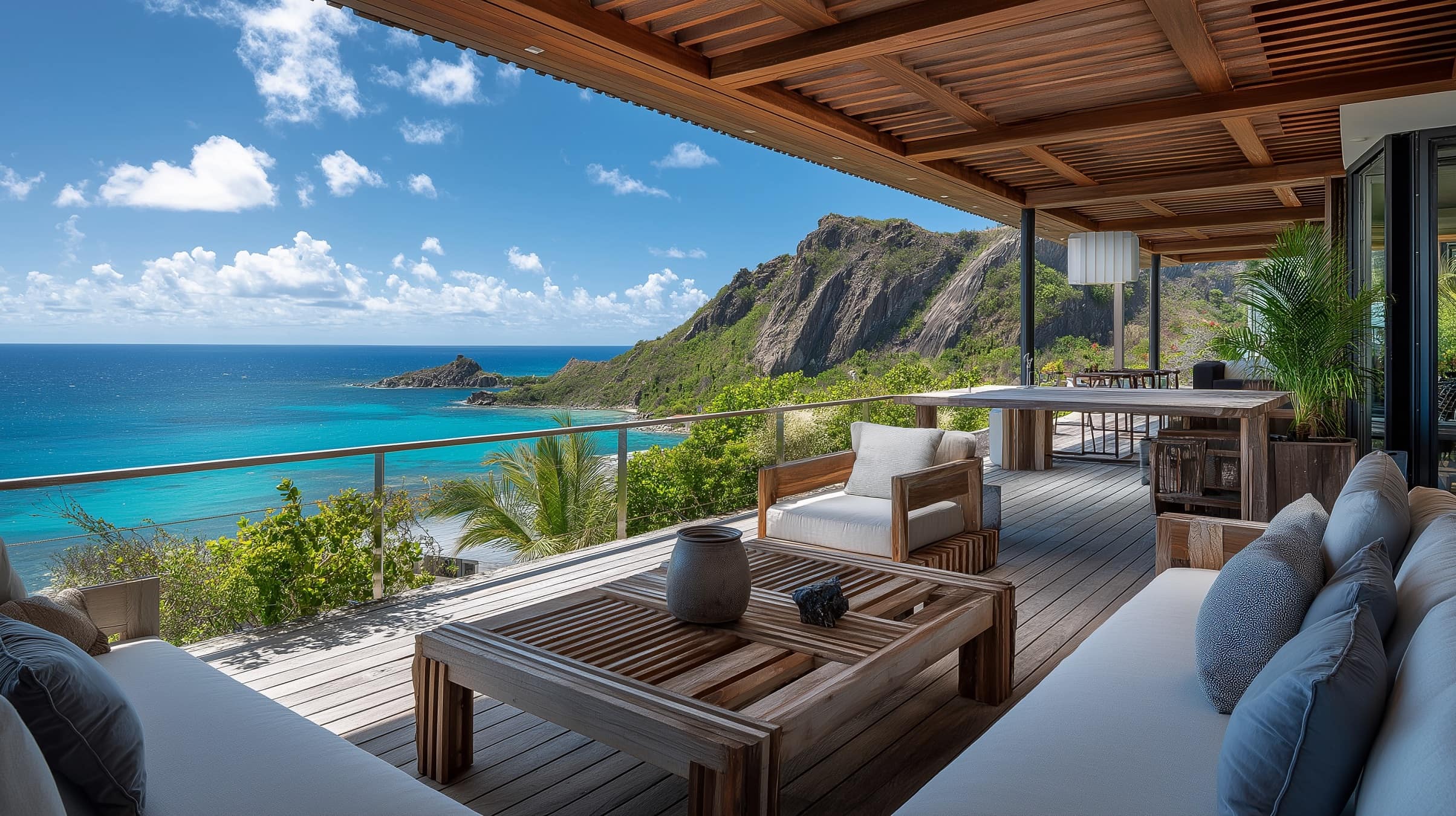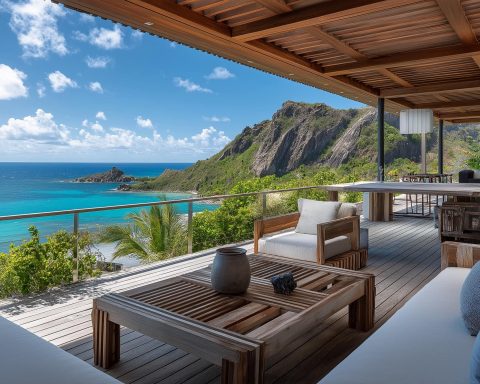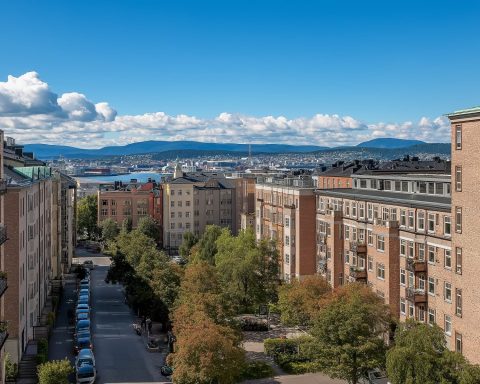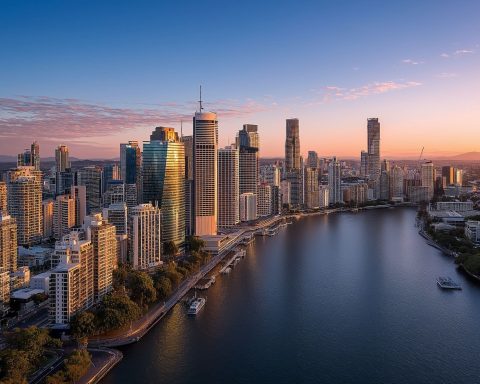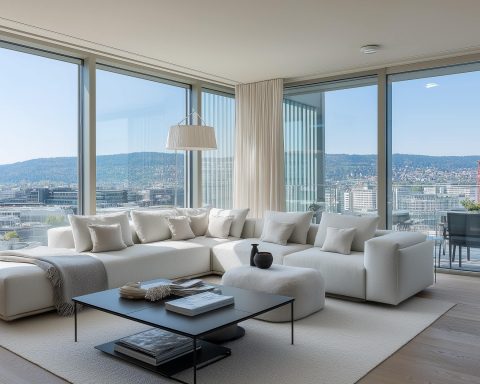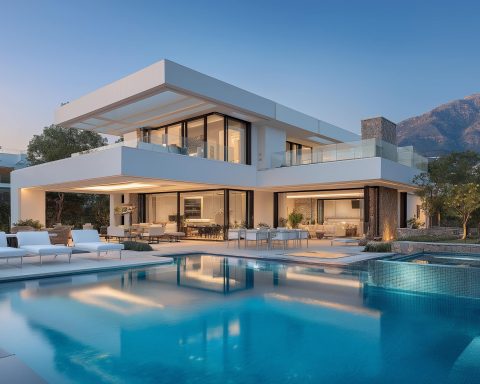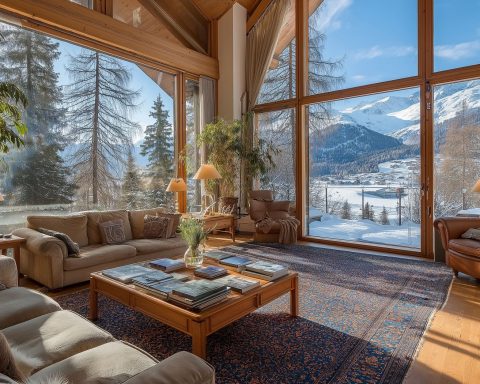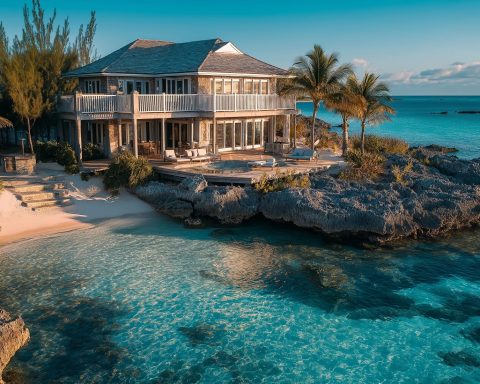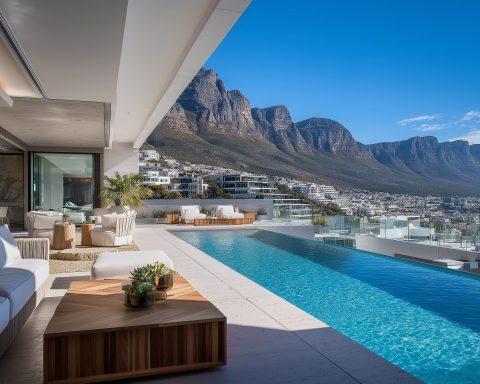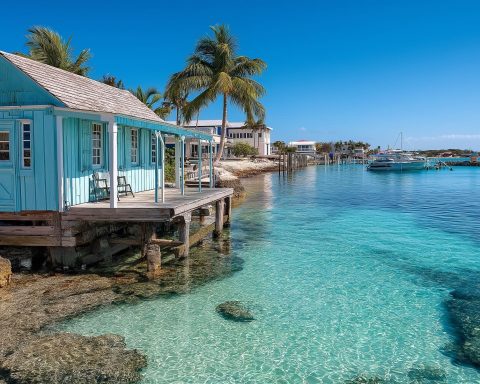Market Overview 2025 – Current Conditions and Performance
St. Barts’ Luxury Real Estate Landscape: The island of Saint Barthélemy (St. Barts) is famed for its ultra-exclusive real estate market. In 2025, the market remains robust but is transitioning from the frenetic boom of the early 2020s into a more stabilized phase. After a post-pandemic surge that saw record demand and soaring prices, the market regained equilibrium by late 2022, cooling from its peak pace of growth roche-realty.com luxurytribune.com. Buyer interest is still high and inventory is extremely tight, but the sharp price spikes have leveled off. Properties now spend a bit longer on the market, especially at the very high end, indicating that prices reached a plateau and are undergoing minor downward adjustments in some ultra-luxury segments roche-realty.com. For example, estates priced above €10 million that once sold within a year are now taking up to two years, often closing only after price reductions of 12–20% roche-realty.com. This moderation reflects a healthier balance between buyers and sellers after years of seller’s market conditions.
Importantly, St. Barts real estate has proven its resilience through global turbulence. Even during the 2008 financial crisis and 2020’s pandemic shock, property values held firm or even rose luxurytribune.com. In fact, the aftermath of Hurricane Irma in 2017 and the COVID-19 pandemic both boosted the market’s momentum – property values jumped roughly 20% after Irma and another 20% during the COVID era as affluent buyers sought safe, secluded retreats luxurytribune.com. By 2023, the market was described as “stronger than ever” following a decade of steady growth luxurytribune.com. Entering 2025, transaction volume remains healthy and inquiries are high, but rising global interest rates have slightly tempered speculative investment luxurytribune.com. The result is a stable, mature market where prices are holding near all-time highs and the island’s reputation as a “millionaire’s circuit” safe haven is intact luxurytribune.com. Long-time observers note that prices on St. Barts have never truly declined, thanks to persistent demand and an extreme scarcity of land luxurytribune.com. This fundamental scarcity – only 8 square miles of paradise – underpins the market’s performance in 2025 and beyond. Experts predict that any short-term cooling will be followed by a return to steady growth around ~10% annually in the long run, given St. Barts’ global cachet and limited supply roche-realty.com. Overall, the 2025 outlook is one of measured optimism: the frantic boom has eased, but the market is solid, exclusive, and poised for sustainable growth going forward jamesedition.com.
Residential Real Estate Trends – Luxury Villas and Housing Types
St. Barts is synonymous with luxury villas, and residential trends in 2025 continue to skew overwhelmingly toward high-end, one-of-a-kind homes. The island’s housing stock ranges from chic condos in Gustavia to sprawling estates in the hills, but lavish villas remain the hallmark. Thanks to strict zoning and building regulations, most new construction is low-density and ultra-premium, ensuring that supply stays perpetually behind demand uniquevillastbarth.com. This has pushed property prices in St. Barts among the highest in the world, on par with top global cities barnes-stbarth.com. Limited developable land, constant demand for second homes, and the high cost of island construction all contribute to keeping prices at stratospheric levels barnes-stbarth.com. It’s not unusual for luxury villas in prime areas (e.g. St. Jean or Gustavia) to command €15,000–€25,000 per square meter (2021 data) uniquevillastbarth.com, and new listings often quietly sell off-market via bidding wars or discreet transactions among wealthy buyers barnes-stbarth.com.
Ultra-Luxury & Design Trends: Many residences are true trophy assets – think hillside estates with panoramic sea views, infinity pools, and designer interiors. Recent years have seen a shift toward “sustainable luxury” in villa design. Buyers are increasingly interested in eco-friendly features and modern architecture that blends with nature barnes-stbarth.com. New builds and renovations frequently incorporate solar panels, rainwater harvesting, and energy-efficient materials, reflecting a trend of eco-conscious high-end development jhmarlin.com. Nonetheless, all construction is heavily regulated: St. Barts’ authorities enforce strict building codes to preserve the island’s charm and environment barnes-stbarth.com. Height and density limits mean there are no high-rises or sprawling developments here – every property must harmonize with the landscape. These policies result in fewer but very exclusive homes. In fact, some villas themselves have become iconic, like the late David Rockefeller’s 52-hectare estate in Colombier which sold for a record €135 million in 2023 luxurytribune.com. Overall, the residential market is characterized by one-of-a-kind properties that seamlessly marry French Caribbean elegance with modern luxury.
Mid-Range and Local Housing: Mid-tier housing in St. Barts is scarce. Smaller villas and apartments (the “entry level” by island standards) still cost in the millions of euros, and demand for anything under ~$3 million far outstrips supply roche-realty.com. Notably, the sub-€2.5M segment saw an influx of listings in the past couple of years and is now experiencing intense competition among buyers roche-realty.com. Even a simple two-bedroom condo can list for over €3 million pre-construction luxurytribune.com. These astronomical prices have made it challenging for local residents to afford housing – a fact recognized by the local government. In response, the collectivité (local government) temporarily suspended new building permit issuance for large luxury projects, aiming to channel development toward improving housing for residents and preserving quality of life roche-realty.com. This means developers are focusing on renovating existing structures or building only within strict limits. Overall, St. Barts’ residential real estate in 2025 remains a niche of extremes: predominantly ultra-luxurious villas for the global elite, a handful of upscale condos, and a dire shortage of affordable homes. The “delicate balance between luxury, exclusivity, and preservation” is an ever-present theme in this market barnes-stbarth.com barnes-stbarth.com – every development decision must respect the island’s natural beauty and limited space.
Commercial Real Estate Developments – Retail, Hospitality, and Office Space
Commercial real estate in St. Barts is uniquely small-scale and service-oriented, reflecting the island’s boutique luxury vibe. There are no sprawling office parks or industrial complexes here – the commercial sector is instead composed of high-end retail boutiques, gourmet restaurants, art galleries, and intimate hotels. Hospitality is the cornerstone of St. Barts’ economy, and recent years have seen significant reinvestment in this sector. Following Hurricane Irma, many of the island’s legendary hotels underwent major renovations and upgrades. For instance, the iconic Eden Rock hotel (a celebrity favorite since the 1950s) reopened after a two-year post-Irma rebuild with new suites, a Jean-Georges restaurant, and a spa, setting “new luxury standards” for the island joycerey.com joycerey.com. The Rosewood Le Guanahani (originally opened in 1986) also re-launched after a complete redesign, and Hôtel Barrière Le Carl Gustaf debuted in Gustavia with 21 chic suites overlooking the harbor joycerey.com joycerey.com. These projects illustrate the trend: instead of new large hotels, St. Barts focuses on refining and expanding existing upscale resorts to meet demand. All hotels remain relatively small (the entire island has only about 500 hotel rooms, which were nearly 100% booked through the 2021–22 high season joycerey.com) – preserving an exclusive atmosphere by avoiding mass tourism crowds.
Retail and dining real estate is concentrated in Gustavia, the picturesque capital. Along the few streets of this yacht-filled harbor town, luxury retailers have set up shop to cater to elite visitors. Designer boutiques (from Louis Vuitton to local haute couture), fine jewelry stores, and art dealers occupy precious storefronts, often in restored colonial buildings. Rents are correspondingly high given the limited supply of commercial space and the affluent clientele. In recent years, there’s been an influx of renowned restaurateurs and hospitality groups expanding to St. Barts, enhancing the island’s status as a culinary and lifestyle destination. Many famed venues from the French Riviera and beyond – “restaurants and beach clubs from St. Tropez” and other luxury hotspots – have invested in St. Barts luxurytribune.com. For example, 2020 saw the opening of Gyp Sea Beach Club (by the creators of Villa Marie hotel) on St. Jean Bay, bringing bohemian-chic dining to the beach joycerey.com. These ventures typically occupy existing spaces (e.g. revamped beach cottages or bar locales) rather than massive new builds.
Notably, any large-scale commercial development faces intense scrutiny. A high-profile case in late 2021 saw local environmental groups successfully block a proposed $170 million hotel project (Hotel Etoile at St. Jean) due to concerns over its size and ecological impact loopnews.com. The court revoked the building permit for that multi-story hotel and underground garage, sending a clear message that “the environment must come first” in St. Barts loopnews.com. This underscores that future commercial projects must align with sustainability and community values. In sum, St. Barts’ commercial real estate development in 2025 can be characterized as selective, upscale expansions: renovating beloved hotels, adding gourmet venues, and improving infrastructure (like the renovated ferry port for smoother arrivals kaori-media.com) – all while avoiding any development that might jeopardize the island’s intimate, high-end charm. Office space per se is minimal; most businesses are in hospitality or luxury retail, and many international homeowners simply work remotely with the island’s new fiber-optic connectivity kaori-media.com. St. Barts has clearly chosen to prioritize quality over quantity in commercial growth, reinforcing its brand as a “boutique paradise” rather than a commercial hub.
Vacation Rental Market – Demand Trends, Occupancy Rates, Revenue Potential
Vacation rentals are a thriving segment of St. Barts’ real estate, crucial to both the tourism economy and property investors. The island’s appeal as a holiday destination for the wealthy means that demand for private villas and rental homes is consistently high – often outstripping hotel capacity (which is limited). As of mid-decade, it’s estimated there are about 1,000 villas available for rent on the island, including roughly 650 luxury villas managed by professional agencies and another 300 more modest homes rented via platforms like Airbnb luxurytribune.com luxurytribune.com. During the peak winter season (December through April), occupancy is virtually maxed out. In an unusually strong 2021/2022 season, for example, officials noted that the island’s hotel rooms were “almost 100% booked” months in advance and that high season started earlier than usual joycerey.com – an indication that villa rentals were likewise snapped up well ahead of time. This trend continued through 2023 and 2024, with St. Barts welcoming a record 292,000 visitors in 2023 (a 10% annual increase) kaori-media.com. These affluent travelers fuel exceptional occupancy rates in vacation properties, especially from late November through New Year’s (when St. Barts is the place to be for celebrities and yacht owners). Even the traditional lull after New Year’s has faded; one report noted no typical January dip in visitors during recent seasons joycerey.com.
Revenue Potential: For property owners, the vacation rental market in St. Barts offers astonishing revenue opportunities. Weekly rental rates for luxury villas rank among the highest in the Caribbean. During the New Year’s holiday week, it’s not uncommon for top-tier beachfront estates to command $100,000 (or more) per week in rent jhmarlin.com. Even outside of holiday periods, large villas often fetch tens of thousands of dollars per week. For instance, a five-bedroom villa in St. Jean was recently listed at €75,000 per week in high season jamesedition.com. Such rates are supported by the caliber of offerings – renters expect (and receive) perks like private pools, gourmet kitchens, housekeeping and concierge services, and panoramic views of the sea uniquevillastbarth.com. High-net-worth vacationers are willing to pay a premium for secluded infinity pools, beachfront access, and bespoke services (private chefs, yacht charters, etc.) uniquevillastbarth.com. As a result, owners who rent out their homes can generate substantial income that often offsets annual maintenance, staffing, and tax costs uniquevillastbarth.com. The strong rental yields are a key part of St. Barts’ investment appeal – a well-positioned villa can produce solid returns while its value appreciates.
Occupancy and Trends: The demand for rentals remains strong year-round, though it fluctuates with the seasons. The winter high season regularly sees occupancy close to 90–100% for both villas and hotels, especially over Christmas/New Year’s and Presidents’ Day weeks joycerey.com. The shoulder seasons (spring and late autumn) still attract many European and American visitors looking for tranquility, keeping occupancy respectable. Even the quiet season (hurricane season in late summer) has been shortening in recent years as the island hosts events and as some travelers prefer off-peak visits. Rental agencies have professionalized the market, with around 70 local real estate agencies handling luxury villa rentals luxurytribune.com. One notable trend is the integration of villa rentals with hotel-level services – for example, some 5-star hotels have their own villa rental arms (Le Barthélemy Hotel & Spa operates “Le Barth Villa Rental” managing 200 villas luxurytribune.com). These hybrids offer guests the privacy of a villa with the amenities of a resort (concierge, daily breakfast delivery, etc.) luxurytribune.com. This has set a new bar for service, further increasing the attractiveness of St. Barts rentals.
In summary, the vacation rental market in 2025 is booming and lucrative. St. Barts’ status as a prestigious playground ensures a steady stream of wealthy visitors willing to pay top dollar. Occupancy rates are high, demand trends are upward, and rental revenues are among the highest in the region. This dynamic is likely to persist, given the island’s carefully maintained exclusivity and the loyalty it commands from upscale travelers (many of whom return every year). For investors, a St. Barts villa offers not just a personal getaway, but also an income-generating asset with “very high rental income potential” thanks to the island’s luxury tourism sector 7thheavenproperties.com.
Investment Outlook – Opportunities, Risks, Returns, and Legal Considerations
Opportunities: Investing in St. Barts real estate is often described as owning a piece of “paradise” – but it’s not just about the lifestyle. The investment fundamentals are compelling. The market is stable, resilient, and exclusively high-end, which historically translates to steady capital appreciation jhmarlin.com. Over the past decade, property values on St. Barts have increased roughly 70% (blending local and international demand) luxurytribune.com. Even when global markets falter, St. Barts’ values tend to hold or rise, owing to its scarcity and cachet as a safe haven for wealth luxurytribune.com. This track record gives investors confidence in long-term returns. Additionally, rental yields are excellent for those who choose to rent out their property. As noted, villas can generate significant weekly income, particularly during peak seasons jhmarlin.com. It’s common for well-located villas to be booked solid for months by repeat clients, effectively providing owners with an income stream in the hundreds of thousands of dollars per year.
St. Barts also offers unique tax and legal advantages that enhance its investment appeal. The island operates under French law but has special fiscal exemptions. Notably, there is no annual property tax on real estate in St. Barts 7thheavenproperties.com – a rare benefit that significantly reduces holding costs for high-value properties. Furthermore, for those who establish residency (which in St. Barts means living there at least 5 years), there is no local income tax on worldwide income barnes-stbarth.com uniquevillastbarth.com. There is also no wealth tax on real estate assets in St. Barts uniquevillastbarth.com, unlike in mainland France. These investor-friendly policies make St. Barts particularly attractive compared to other Caribbean locales or even European luxury markets uniquevillastbarth.com. Transaction costs consist mainly of a one-time transfer tax (~5%) and notary fees (~5–6%) 7thheavenproperties.com jhmarlin.com, which are in line with or lower than many countries’ stamp duties. Foreign buyers are welcomed – there are no restrictions on overseas ownership, and one may purchase in personal name or via an entity/trust as suited jhmarlin.com. Financing is theoretically available through local banks, though most buyers in St. Barts are cash buyers or finance through home-country banks given the clientele jhmarlin.com.
Risks and Considerations: While the outlook is strong, investors should be mindful of certain risks in this exclusive market. First, entry prices are extremely high, so the barrier to entry is significant. It’s not uncommon for even a modest 2-bedroom villa to cost $3–5 million, and luxury estates run into eight figures easily luxurytribune.com luxurytribune.com. This means the market is less liquid; the pool of buyers at the top end is limited globally. As observed in 2023, if properties are overpriced, they can linger on the market until sellers adjust expectations roche-realty.com. High-end homes above €10M might take 1–2 years to sell in a balanced market roche-realty.com. Thus, investors should be prepared for potentially longer hold periods or price negotiations when exiting. That said, properly priced villas in prime locations still move quickly due to pent-up demand. Another consideration is the capital gains tax: to discourage flipping, the local government increased the capital gains tax rate from 20% to 35% on properties resold within the first 8 years of ownership roche-realty.com. After 8 years, standard French capital gains regimes apply (which taper down the tax on long holds). This policy, enacted in 2017, means investors should ideally have a medium-to-long term horizon or face a hefty tax if selling in under 8 years.
Legal and regulatory nuances: When purchasing, investors must use a local notary (notaire) to handle the transaction, as required by law jhmarlin.com. The notary conducts due diligence, ensures clear title, and registers the deed. Notary and registration fees total roughly 6–7% of the purchase price jhmarlin.com. It’s a straightforward process in practice, but buyers should factor these closing costs into their budget. There are no citizenship or residency requirements to own property – anyone can buy, whether or not they reside on the island 7thheavenproperties.com. However, if one does wish to reside long-term, non-EU citizens will need to obtain a long-stay visa or residency permit (since St. Barts, while French, is outside the Schengen area) 7thheavenproperties.com 7thheavenproperties.com. Another consideration is insurance and storm risk: as a Caribbean island, St. Barts faces hurricane season. Properties are built to stringent hurricane-resistant standards (“Cyclone-proof” construction is common) to protect these investments uniquevillastbarth.com. Insurance premiums can be high but are a necessary safeguard. The island’s quick recovery after past storms (like Irma) has proven the market’s resilience and the community’s commitment to rebuilding swiftly luxurytribune.com.
In summary, St. Barts offers a rare combination of investment security and glamorous returns. The market’s exclusivity and history of appreciation present strong upside, while low-tax policies 7thheavenproperties.com uniquevillastbarth.com and high rental yields mitigate holding costs. Investors should be prepared to commit for the long term and navigate a competitive, relationship-driven market (local expert agents are invaluable). But for those who do, the reward is not only solid financial performance but also the intangible dividend of owning a “legacy” property in one of the world’s most idyllic locales uniquevillastbarth.com uniquevillastbarth.com.
Neighborhood Spotlight – Top Areas to Buy or Invest in St. Barts
Though tiny, St. Barts offers diverse micro-markets, each with its own allure. Here are some of the top neighborhoods and areas that investors and homebuyers covet:
- Gustavia: The island’s charming capital and main port, Gustavia is a vibrant hub of activity. Its red-roofed buildings and marina filled with superyachts create an unmistakable appeal. Buying in Gustavia means access to luxury boutiques, gourmet restaurants, and the island’s best shopping and nightlife jhmarlin.com. Properties here include stylish harbor-view apartments and the rare villa in the hills above town. Given its convenience and lively atmosphere, Gustavia is ideal for those who want to be “in the middle of it all” – yet it remains exclusive (inventory is limited, and prices reflect the central location with multi-million-dollar condos not uncommon). The bonus: gorgeous sunset views over the harbor and proximity to Shell Beach for a quick swim.
- St. Jean: Just over the hill from Gustavia lies St. Jean, often considered the second-most popular area. St. Jean Bay boasts a stunning turquoise beach and is home to the famed Eden Rock Hotel and Nikki Beach club. It’s a chic, bustling area by day – think beachside bistros, watersports, and boutique shopping. The St. Jean neighborhood offers a mix of properties, from hillside villas overlooking the bay to a few beachfront cottages (extremely rare) jhmarlin.com. This area is a favorite of those who want resort-like energy: you can walk to restaurants, watch small planes land at the tiny airport, and enjoy a sociable beach scene. Villas in St. Jean command premium prices due to the coveted location; many have panoramic bay views and easy beach access, making them top performers for vacation rentals as well.
- Pointe Milou: Jutting out on the north coast, Pointe Milou is an ultra-exclusive residential enclave known for some of the most spectacular villas on St. Barts. Perched on cliffs and hills, properties in Pointe Milou feature sweeping sea views in almost every direction. It’s famously one of the best places on the island to watch the sunset, which is a major draw for evening cocktails by the infinity pool jhmarlin.com. Pointe Milou is peaceful and private – there are no hotels here, just high-end villas that often remain in elite hands for years. This area appeals to those seeking tranquility, privacy, and dramatic scenery. It’s also popular for luxury rentals (sunset views are a big selling point for renters). Homes here tend to be contemporary and expansive, and few ever come to market. When they do, they are among the priciest on the island, reflecting Pointe Milou’s desirability and limited supply.
- Lorient & Saline: On the northern coast, Lorient offers an appealing blend of local charm and beachfront beauty. It’s a more laid-back village atmosphere, with a lovely reef-protected beach popular with surfers and families 7thheavenproperties.com. Lorient is one of the island’s historic settlements (even hosting a local church and school), so it has a subtle community vibe. Villas in the Lorient hills enjoy lush surroundings and ocean panoramas, often at (slightly) more accessible prices than St. Jean. Just over the hill to the south is Saline, known for the pristine Saline Beach – a breathtaking, undeveloped expanse of sand often ranked among the world’s best. Saline itself has very few properties (development near the beach is restricted), but the Petite Saline and Grand Saline areas above it contain luxury homes that boast both country tranquility and proximity to the famous beach 7thheavenproperties.com. Investors like Lorient and Saline for their mix of serenity and natural beauty – you’re a bit removed from the tourist buzz, but still only 10 minutes from Gustavia.
- Colombier & Flamands: The northwestern tip of St. Barts is a must-mention for its breathtaking scenery. Colombier is remote and utterly tranquil – its gorgeous beach (accessible only by boat or hiking path) ensures the area stays quiet and exclusive jhmarlin.com. Villas in Colombier are perched atop cliffs or hidden in lush enclaves, many with views toward the surrounding islets and the sea sunsets. Adjoining Colombier is Flamands, home to the island’s largest beach. Flamands Beach features a few upscale boutique hotels and beachfront villas, but remains uncrowded and peaceful jhmarlin.com. The hills around Flamands host many high-end residences; owning here means steps from a picture-perfect white sand beach in a more residential, private part of the island 7thheavenproperties.com. Properties in Colombier and Flamands are highly sought after – Colombier for its seclusion (some estates have immense parcels of land by island standards), and Flamands for its beachfront allure. Both areas see strong interest from buyers who value nature, and their villas also perform well as rentals for those seeking quieter surroundings.
Other notable areas include Gouverneur, with its exclusive hillside villas overlooking one of the prettiest secluded beaches (Gouverneur Beach), and Lurin, a hillside area just south of Gustavia known for commanding views of the harbor and sunsets. Toiny and Grand Cul-de-Sac on the eastern side offer rugged coastline beauty and are gaining interest for their relative value and new luxury developments (like revitalized hotels and villa projects) 7thheavenproperties.com. No matter the locale, every part of St. Barts shares a common thread: stunning natural scenery and an atmosphere of luxury. The “best” neighborhood often comes down to personal preference – whether one prioritizes being in-town versus secluded, sunset views versus beachfront access, or proximity to activities versus untouched nature. What is uniform across the island is the exclusivity – each of these areas represents a top-tier investment target in the Caribbean, offering not just real estate, but a coveted lifestyle that is uniquely St. Barts 7thheavenproperties.com 7thheavenproperties.com.
Pricing Trends and Forecast – Sales and Rental Prices Over Time
St. Barts real estate has seen extraordinary price growth over the past decade, and understanding the trajectory provides context for future forecasts. In the 2010s, property prices on the island climbed steadily year after year, with an approximate 70% increase in average price-per-square-meter over 10 years luxurytribune.com. This long bull run was punctuated (but not derailed) by external events. Notably, after the devastation of Hurricane Irma in 2017, the swift reconstruction and renewed interest led to a roughly 20% jump in values as confidence surged luxurytribune.com. Then, during the COVID-19 pandemic (~2020–2021), as ultra-wealthy individuals sought private retreats, St. Barts saw another ~20% rise in prices luxurytribune.com – effectively a pandemic-driven boom. By 2022, anecdotes of record-breaking deals were making headlines: for example, the Rockefeller estate selling at €135 million (an eye-popping number even by global luxury standards) luxurytribune.com. At the peak of the frenzy, turnkey luxury villas in prime spots routinely asked upwards of €20–€40 million, and even modest apartments crept into the several-million range luxurytribune.com.
Current price levels (2025): As of 2025, St. Barts firmly ranks among the most expensive markets on the planet (often compared to Monaco or Manhattan in price per square foot). Entry-level studios or one-bed condos (rare as they are) hover around the €1–2 million mark luxurytribune.com. A comfortable 3–4 bedroom family villa in a good location will typically list for mid to high single-digit millions in euros. The top-tier estates – sprawling properties with prime land and views – can range from about €15 million up to €50–60 million for the absolute best (there have been listings quietly marketed even higher, depending on pedigree and land size) luxurytribune.com. To illustrate, a new listing for a 56 m² (600 sq. ft) two-bedroom apartment in Gustavia was announced at €3.15 million off-plan luxurytribune.com, underscoring that even the smallest properties carry hefty price tags. On a per-square-meter basis, €20,000–€30,000/m² is not unusual for luxury villas, with some exceptional cases exceeding that (especially for smaller beachfront plots which exaggerate the unit rate). The average price of properties sold is hard to pinpoint (due to many off-market deals), but local agents have indicated it’s well into the multimillions. One lawyer quipped that St. Barts prices are at “Monaco levels from seven years ago,” implying they have reached a rarified tier and continue climbing luxurytribune.com.
On the rental price side, St. Barts has similarly set Caribbean records. Average daily rates (ADR) for hotels are the highest in the region, and the villa market follows suit. Luxury villas regularly rent for $20,000–$50,000 per week in high season, with ultra-luxury estates fetching $80k+ for holiday weeks jhmarlin.com jamesedition.com. Over the past decade, rental rates have also risen in tandem with real estate values – roughly doubling in many cases from the early 2010s to mid 2020s (though precise data is private). However, investors find comfort in that high demand has maintained strong occupancy and rising rental yields, absorbing these price increases.
Forecast 2026–2028: Looking ahead, expert forecasts and market factors suggest a cautiously optimistic picture. After the cooling in 2023–2024 (where the market **“stabilized” from unsustainable growth rates roche-realty.com), most analysts expect that values will resume a steady upward climb at a more measured pace. A prominent local agency predicts long-term price growth around 8–10% per year going forward, rather than the sharp jumps of the past – essentially a return to normalcy in an extraordinary market roche-realty.com. There are a few reasons for continued growth: demand remains far greater than supply – St. Barts will always be land-constrained; plus, the island’s prestige only seems to increase, attracting new generations of high-net-worth buyers. Additionally, some new inventory may hit the market in the mid-priced segment: homes built after 2017 (post-Irma) will reach the 8-year milestone in 2025, meaning owners can sell without the extra capital gains tax roche-realty.com. This could free up more villas in the €2–6 million range starting in 2024/25, potentially easing pressure there and increasing transaction volumes roche-realty.com. But any influx is relative – we’re talking dozens of homes, not hundreds. And critically, the island’s government remains committed to tight development controls, including limiting new construction permits luxurytribune.com. Thus, the scarcity that drives prices is unlikely to change.
One factor that could shape pricing is the global economic environment. If interest rates stay high or there’s a broader recession, ultra-luxury markets might see a slight dampening of enthusiasm. St. Barts is somewhat insulated (its buyer pool is largely cash-rich), but a downturn could slow price growth temporarily as seen with a slight investor pause in 2023 luxurytribune.com. However, as history shows, once conditions improve, St. Barts real estate tends to surge back with vigor. Rental prices are expected to keep pace or even outpace inflation; the Tourism Committee is working on strategies to maintain high visitor numbers while preserving exclusivity kaori-media.com kaori-media.com – a balancing act that if successful, will support rental demand and allow rental rates to increase further, especially for top properties.
In summary, prices in St. Barts are forecast to remain on an upward trajectory through 2028, albeit at a moderated single-digit growth rate rather than explosive jumps. We are likely to see the island breaking its own records gradually – new benchmark sales will happen (e.g. the first $100 million listing, perhaps), and rental rates will edge up as the island continues to enhance its luxury offerings. St. Barts’ real estate will continue to be a seller’s market in the long run given permanent supply constraints. As one local expert put it: “This island has become a high-end brand, and prices are closely tied to the scarcity of properties available.” roche-realty.com Investors can thus expect with some confidence that their St. Barts assets will appreciate over time, all while generating top-tier rental returns in the interim.
Comparison with Other Caribbean Islands – Similarities, Advantages, and Differences
St. Barts occupies a unique niche in the Caribbean real estate landscape. When compared to other islands in the region, several key differences and advantages stand out:
- Exclusivity and Price Point: St. Barts is unquestionably one of the most exclusive (and expensive) markets in the Caribbean. While other islands like Barbados, the Bahamas, Cayman Islands, or St. Martin do have luxury properties, St. Barts’s price levels are significantly higher on average jhmarlin.com. The island’s “limited availability of land” and resultant low supply mean even small homes sell for multi-millions barnes-stbarth.com. For example, a luxury villa in Turks & Caicos or the Bahamas might be priced in the single-digit millions, whereas a similar-caliber villa on St. Barts could be double or more. St. Barts is often likened to destinations like Monaco or St. Tropez for its density of wealth. In contrast, nearby St. Martin offers more varied and accessible price points – you can find high-end villas there, but also many mid-market condos, something St. Barts largely lacks sxmsir.com. This means St. Barts caters almost exclusively to ultra-high-net-worth buyers, whereas other islands have broader market segments. The upside of this exclusivity is that St. Barts has very little speculative oversupply; markets like the Dominican Republic or parts of the Bahamas have seen large condo developments that don’t exist on St. Barts.
- Legal and Tax Environment: Many Caribbean locales attempt to lure investors with tax incentives or citizenship programs (for instance, St. Kitts & Nevis’s citizenship-by-investment or Cayman’s no income tax). St. Barts, however, being part of France, does not offer citizenship for purchase and has EU oversight – yet it still boasts huge tax advantages that rival or exceed other islands uniquevillastbarth.com. As mentioned, no property tax and no estate tax on real estate in St. Barts give it an edge even over other tax havens like the Bahamas (which has property tax) or Barbados (which has annual property levies). St. Barts also has no restriction on foreign buyers 7thheavenproperties.com, unlike some islands that require licenses or have limits on foreign ownership (e.g., certain territories require an Alien Landholding License or limit foreign land purchases). One more subtle edge: political stability and currency. St. Barts benefits from French governance – the rule of law is strong, and contracts are enforced under a reliable legal system. The currency is the Euro, a stable global currency, which can be comforting for European buyers (versus some islands with weaker or pegged currencies). The stable governance is a contrast to a few independent Caribbean nations that have seen political or economic volatility. In short, St. Barts offers the security of a European jurisdiction combined with the tax freedoms of a Caribbean haven – a unique combination that many competitors can’t fully match uniquevillastbarth.com.
- Tourism and Rental Demand: Compared to other islands, St. Barts has an unusually high proportion of repeat and affluent tourists. Places like the US Virgin Islands or Puerto Rico get far more visitors in absolute numbers, but those include cruise ship passengers and mass-market tourism. St. Barts deliberately forgoes cruise tourism and large resorts, focusing on upscale visitors. The result is an arguably higher-end rental market than almost anywhere else in the region. For example, while Barbados and Turks & Caicos have plenty of luxury villas and do see high rates, St. Barts consistently achieves some of the very highest weekly rents in the Caribbean jhmarlin.com. The island’s mystique and celebrity appeal (frequented by A-listers and billionaires) give it a glamor factor often compared to St. Tropez or Capri, which few Caribbean islands share to the same extent. That said, islands like Anguilla or Mustique share similarities in exclusivity (Mustique is extremely exclusive but is privately owned and more for personal estates than investment). Turks & Caicos has also targeted the luxury market and has no property tax, attracting high-end developments – but it has far more developable land and larger projects (e.g., condo-hotels) which St. Barts lacks. Sint Maarten/Martin, right next door, offers a instructive contrast: the French side (St. Martin) is actually a neighboring French territory but with a different status and more relaxed taxes for residents; it has more inventory and lower prices, making it “luxury meets affordability” relative to St. Barts hauteretreats.com. However, St. Martin also contends with higher crime in certain areas and a less polished overall image. St. Barts, by remaining small and exclusive, has extremely low crime and a polished infrastructure, which wealthy buyers find reassuring.
- Infrastructure and Lifestyle: Many Caribbean islands have beautiful beaches and nice homes, but St. Barts distinguishes itself with a certain European sophistication and meticulous upkeep. The influence of French culture means excellent restaurants, stylish boutiques, and a focus on quality of life. Roads are well-maintained, utilities are reliable (now with island-wide fiber internet kaori-media.com), and healthcare is of French standard for residents. Other islands might have larger malls or casinos (which St. Barts does not) catering to a broader tourist base. For instance, Saint-Martin (Dutch side) has big grocery stores, nightclubs, and even KFC – St. Barts intentionally avoids such development to maintain its brand. The trade-off is that St. Barts has limited convenience for large-scale shopping or direct international flights. Its airport can only handle small planes, meaning you must connect via St. Maarten or elsewhere, whereas other islands like Antigua or Barbados have big international airports with direct flights from major cities. Some investors prefer easier access, but others see the access challenge as a moat that preserves exclusivity. Similarly, islands like the Bahamas or Cayman have extensive financial services and expat communities with more year-round business activity. St. Barts is quieter and more purely leisure-focused – which is exactly what its buyers want.
In summary, St. Barts’ advantage lies in its unparalleled mix of exclusivity, stability, and luxury. It is often contrasted with St. Martin: one publication notes that while St. Barthélemy stands out for “exclusivity and luxury appeal,” St. Martin offers a more accessible market with a wider range of prices sxmsir.com. For those who can afford it, however, St. Barts offers a unique investment proposition: a secure, ultra-prime market in the heart of the Caribbean. Few other islands can match the combination of no annual taxes, no ownership restrictions, a consistently high-end tourist flow, and governance by a G7 country. Investors often consider St. Barts alongside global elite markets rather than just Caribbean peers. Of course, every Caribbean island has its charm – some have golf courses, casinos, or larger plots of land which St. Barts lacks. But in the realm of luxury real estate, St. Barts is the crown jewel of the Caribbean, often cited as the region’s answer to the French Riviera for the rich and famous. This singular position means its market dynamics are distinct, and it often leads the Caribbean in price trends rather than follows. In the words of one investment firm, “St. Barts remains a stable and highly desirable real estate market,” offering an unmatched blend of natural beauty and exclusivity that neighboring territories cannot easily replicate seaglassproperties.com uniquevillastbarth.com.
Government Policies and Regulations – Real Estate Laws, Foreign Ownership, Taxes
St. Barts’ government and regulatory environment have been deliberately shaped to encourage upscale investment while protecting the island’s heritage and environment. Here are the key policies and regulations impacting real estate:
- Foreign Ownership: There are no restrictions on foreign nationals purchasing property in St. Barts 7thheavenproperties.com. Unlike some countries that limit foreign buyers or require special licenses, St. Barts (and France) allow anyone – whether a resident or not – to buy and own freehold property. International buyers have exactly the same rights as locals in this regard. As a result, a large portion of St. Barts properties are owned by foreigners (roughly 40% by French mainlanders, 25% by Americans, 5% other Europeans, with the remainder local) luxurytribune.com. The buying process is straightforward: a notary handles the transaction, the buyer pays a 10% deposit upon signing the sale agreement, and closing typically occurs in 2–3 months with the balance paid and deed registered 7thheavenproperties.com. The lack of ownership hurdles has made it easy for international high-net-worth individuals to invest in St. Barts real estate as and when they find the right property.
- Taxes and Fees: St. Barts’ tax regime is famously favorable:
- No Annual Property Tax: Uniquely, St. Barts imposes no yearly property tax or land tax on owners 7thheavenproperties.com. Once you’ve purchased, you won’t get a local property tax bill. (There is a modest “occupancy” fee or habitation tax for property owners, but this has been largely nominal and in some cases waived – vastly less than typical property taxes abroad) jhmarlin.com.
- No Income Tax for Long-Term Residents: If one becomes a full-time resident of St. Barts (and meets the 5-year residency requirement for fiscal domicile), there is no local income tax on personal income barnes-stbarth.com uniquevillastbarth.com. This policy, inherited from the island’s historical status, effectively makes St. Barts a tax haven for those who truly move there. It’s worth noting that this benefit primarily applies to French nationals or others who legally establish St. Barts as their home; non-resident owners would simply pay their usual taxes in their home country, as St. Barts won’t tax their rental or resale income.
- No Wealth Tax on Real Estate: France formerly had a wealth tax on global assets (including real estate) for its residents, but St. Barts negotiated an exemption. There is no French wealth tax on properties in St. Barts uniquevillastbarth.com, making it attractive to wealthy investors who might otherwise face annual wealth taxes on expensive homes in places like Geneva or Paris.
- Transaction Taxes: The primary tax associated with real estate is a transfer tax (droits de mutation) of approximately 5% paid by the buyer at closing 7thheavenproperties.com. This is similar to a stamp duty. Additionally, notary fees of around 2.5% plus registration and other ancillary fees ~2–3% bring the typical closing costs to about 6–7% of the purchase price for the buyer jhmarlin.com jhmarlin.com. Sellers do not pay stamp duty, but if they realize a capital gain, that may be taxed (more on that next).
- Capital Gains Tax: For non-residents, France levies a capital gains tax on the sale of secondary properties. As mentioned, St. Barts raised the rate to 35% on gains if the property is held less than 8 years roche-realty.com, after which standard French rates apply (which gradually reduce the taxable gain over 22 years for buildings). This was intended to discourage short-term flipping and speculation roche-realty.com. If a seller is a resident of St. Barts, different rules can apply, but most foreign owners should factor this in if planning to resell in the short term.
- Rental Income Tax: There is no local income tax, so rental income generated in St. Barts isn’t taxed by the island. However, many owners channel rental income through companies or pay taxes on it in their home jurisdictions as required. Also, a rental property may be subject to a communal lodging tax (taxe de séjour) passed on to renters per night, similar to hotel taxes, but this is a minor consideration and part of the guest’s expense, not the owner’s.
- Building Regulations and Zoning: The island’s authorities maintain very strict zoning laws and development regulations to preserve St. Barts’ natural beauty and low density. Building permits can be difficult to obtain – especially for new constructions. In fact, as referenced earlier, the collectivity has at times halted issuing new building permits to control growth roche-realty.com. When permits are granted, there are height restrictions (usually no more than 1–2 stories for residential), limitations on how much of a plot can be built (to avoid overbuilding and to protect green space), and architectural guidelines to ensure aesthetic harmony. The government is also actively considering tightening regulations in coastal zones due to climate change; one official pointed out that construction is still technically allowed on some beachfronts, but “with rising sea levels, these areas should be preserved to avoid villas being underwater in 10–15 years”, advocating for updated rules luxurytribune.com luxurytribune.com. Already, huge mega-villas are discouraged – the local code limits overly large structures to ensure they integrate into the landscape luxurytribune.com. Most development focuses on replacing or renovating existing homes rather than building on untouched land luxurytribune.com. The upshot is that real estate transactions mostly involve existing villas, and large raw land sales are rare (and usually come with restrictive development rights) luxurytribune.com. Environmental impact studies are required for significant projects, and, as we saw with the Hotel Etoile case, even a fully approved permit can be revoked if public outcry and environmental concerns arise loopnews.com. St. Barts authorities also ensure infrastructure keeps pace: there are regulations on water use (many villas have cisterns for rainwater) and strong rules around preserving the coastline and reefs.
- Rental Regulations: Owners who rent their properties short-term are generally allowed to do so freely, as villa rentals are a staple of the economy. However, they must register and obtain a rental permit and possibly a tourism license for legal short-term renting uniquevillastbarth.com. This is usually a formality handled by rental agencies. The government wants to ensure safety and quality standards (e.g. fire safety, sanitation) are met in rental villas, given they effectively operate like hotels. Additionally, rental income should include charging the “Taxe de Séjour” (visitor lodging tax) to guests, which is remitted to the local treasury. There has been talk of limiting the number of days per year an owner could rent (as some cities do), but currently St. Barts has no such restriction – largely because tourism is its lifeblood.
- Residence and Visas: While not a direct real estate law, it’s worth noting: owning property in St. Barts does not automatically confer residency or immigration rights, since it’s a French territory. EU citizens can reside freely. Americans, Canadians, and others can stay up to 90 days visa-free, but longer stays require a visa or residency permit 7thheavenproperties.com 7thheavenproperties.com. After 5 years of lawful residence, one can apply for French permanent residency or even citizenship 7thheavenproperties.com. However, there is no investment visa program specific to St. Barts – the pathway to residency is more about proving you have the means to live there and integrating over time. Many property owners simply visit on vacation and do not become residents; those who do often appreciate that St. Barts remains free of direct taxes on them.
In summary, St. Barts’ regulatory framework balances investor-friendliness with strict preservation. On one hand, it’s easy to buy, with a secure legal system and minimal taxation – the island “welcomes investment from overseas buyers” and has “no restrictions” on purchase 7thheavenproperties.com. On the other hand, once you own, you’ll face a highly regulated building environment: you can’t just tear down and build a mansion that breaks the rules, and any development will be closely scrutinized for environmental impact barnes-stbarth.com luxurytribune.com. The government’s philosophy is clearly to protect what makes St. Barts special – its natural beauty, exclusivity, and small-scale charm – which in turn protects property values long-term. As a result, the laws and policies generally enhance the appeal of investing (through favorable financial treatment) while limiting the risk of overdevelopment that could spoil the market. This delicate balance is why St. Barts is often cited as a model in the region for sustainable luxury development.
Future Projections – Expert Forecasts for 2026–2028
Looking toward the future, St. Barts’ real estate market is expected to continue thriving, with some evolution in line with global trends and local policies. Experts universally forecast growth, albeit more measured than the recent past. Roche Realty’s 2023 market update projected that after a brief slowdown, St. Barth’s could see a “long-term steady growth of about 10% per year” in property values roche-realty.com. This optimistic outlook is underpinned by the island’s enduring fundamentals: persistent high demand, limited supply, and a brand cachet that keeps the world’s wealthy coming back. St. Barts has effectively solidified itself as a perennial “it” destination, and that is unlikely to change by 2028. In fact, the Tourism Board expects visitor numbers in 2024 to hold at record highs similar to 2023’s ~292,000 visitors, and they are proactively managing the island’s capacity to keep tourism sustainable kaori-media.com. This suggests the rental market and indirectly the real estate sector will enjoy a stable or growing client base.
One anticipated development is a potential increase in available listings around 2025–2026, as mentioned earlier, due to owners hitting the 8-year mark since the 2017 capital gains tax rule roche-realty.com. If some choose to cash out, buyers might finally have a bit more choice, particularly in the mid-range villa segment (€3–6M). This could marginally moderate price acceleration in that band, but given how hungry the market is, any new supply is likely to be snapped up quickly. On the construction front, new projects will be few – the moratorium on new building permits for large projects might loosen once the government finalizes updated urban plans focusing on climate resilience (preventing beach overbuilding, etc.) luxurytribune.com luxurytribune.com. It’s expected that future development will emphasize sustainable, eco-friendly building: solar-powered homes, electric vehicle infrastructure, and preserved green spaces, aligning with the global push for sustainability. St. Barts is actually ahead of the curve here, as many new villas already feature solar and gray-water recycling, and the island leadership emphasizes green initiatives (e.g. converting waste to energy at its treatment plant) kaori-media.com. So by 2026–2028, we may see St. Barts marketed not only as a luxury haven but also as an eco-conscious luxury community, which could attract a new wave of environmentally-minded affluent buyers.
In terms of pricing, aside from the general upward trend, there may be specific milestones reached by 2028. We might see the first consistent €100,000 per week rentals for ultra-villas during peak season, given that €75k/week is already achieved jamesedition.com. On sales, while it’s speculative, the continued wealth creation globally (and interest in hard assets like prime property) could produce sales that break current records. Perhaps another estate sale in the €100M+ range could occur if a truly one-of-a-kind property (like a large family estate or a compound) comes to market. Such sales often reset the bar for the entire island’s pricing. Knight Frank’s global wealth reports have frequently noted that the “prime international residential market” in places like St. Barts tends to track global high-net-worth population growth – which is forecast to rise in coming years. So as more ultra-rich individuals are minted (especially in the U.S. and Europe, who are key buyer demographics), St. Barts should see new buyers entering the market and keeping demand strong.
Potential risks or changes on the horizon include macroeconomic factors and regulatory shifts. If global economic conditions worsen, St. Barts could see a short-term dip in transactions (like any discretionary luxury market) – but its track record suggests resilience. Interest rate rises have already cooled the pace a bit luxurytribune.com, but many buyers here are not interest-rate sensitive (cash buyers). Geopolitical stability favors St. Barts; if some other jurisdictions become less friendly to wealth (through taxes or instability), St. Barts could ironically benefit as a wealth refuge. The island’s government will convene in 2025 for “Assises du Tourisme” to shape tourism’s future kaori-media.com – any decisions there (e.g., capping visitor numbers to preserve exclusivity, or infrastructure investments) will indirectly affect real estate. For instance, if they choose to limit tourism growth, that preserves the exclusive atmosphere (good for property values), whereas if they carefully expand capacity (perhaps allowing a couple of new small hotels or events like the planned fashion show in 2026 kaori-media.com), that could further boost the island’s profile and desirability.
By 2028, St. Barts will likely continue to shine as the Caribbean’s premier luxury market. One lawyer famously said “Prices have never dropped [here]” luxurytribune.com – and barring a catastrophic event, that is likely to remain true. The consensus among experts is that investing in St. Barts will remain a sound bet: the market is “very solid” and essentially backed by the finite nature of the island and its cachet luxurytribune.com. Even climate change, a concern for any island, is being proactively addressed through adjusted building codes and protective measures luxurytribune.com, meaning St. Barts is working to safeguard its long-term habitability and value. If anything, climate challenges could make the high ground villas with elevation even more prized.
In conclusion, the 2026–2028 forecast for St. Barts real estate is largely positive. We expect moderate price growth year-on-year, sustained high rental demand, and a continued influx of global elites investing in property. St. Barts will keep its status as a trophy destination – a place where owning real estate is as much about passion and lifestyle as it is about investment. For those looking at the island in the coming years, the advice from local experts remains: don’t wait too long. The market has a way of running away; as one analysis put it, St. Barts is “the ultimate Caribbean dream” where the pinnacle of island living today is likely to become even more unattainable (and valuable) tomorrow 7thheavenproperties.com 7thheavenproperties.com.
Sources: Saint Barthélemy Real Estate Market Reports and Guides seaglassproperties.com jhmarlin.com; Roche Realty Market Update 2023 roche-realty.com roche-realty.com; Luxury Tribune (2023) luxurytribune.com luxurytribune.com; Barnes St. Barth Blog barnes-stbarth.com barnes-stbarth.com; JH Marlin Legal Guide (2024) jhmarlin.com jhmarlin.com; 7th Heaven Property Guide 7thheavenproperties.com 7thheavenproperties.com; Unique Villas St. Barth (2025) uniquevillastbarth.com uniquevillastbarth.com; JamesEdition Market Trends (2025) jamesedition.com jamesedition.com; St. Barth Tourism Committee (2024) kaori-media.com kaori-media.com; Loop News (Hotel Permit case) loopnews.com.
